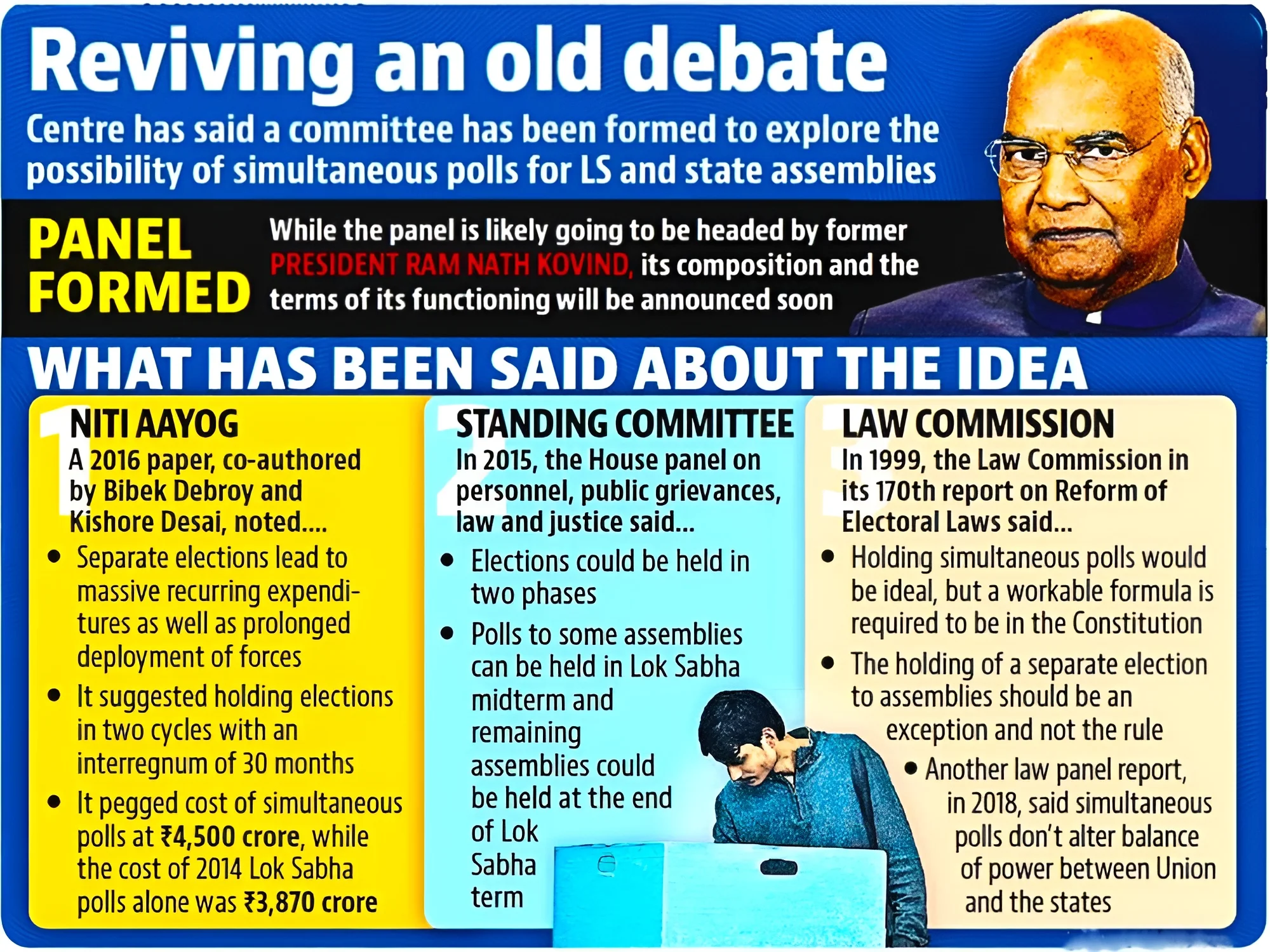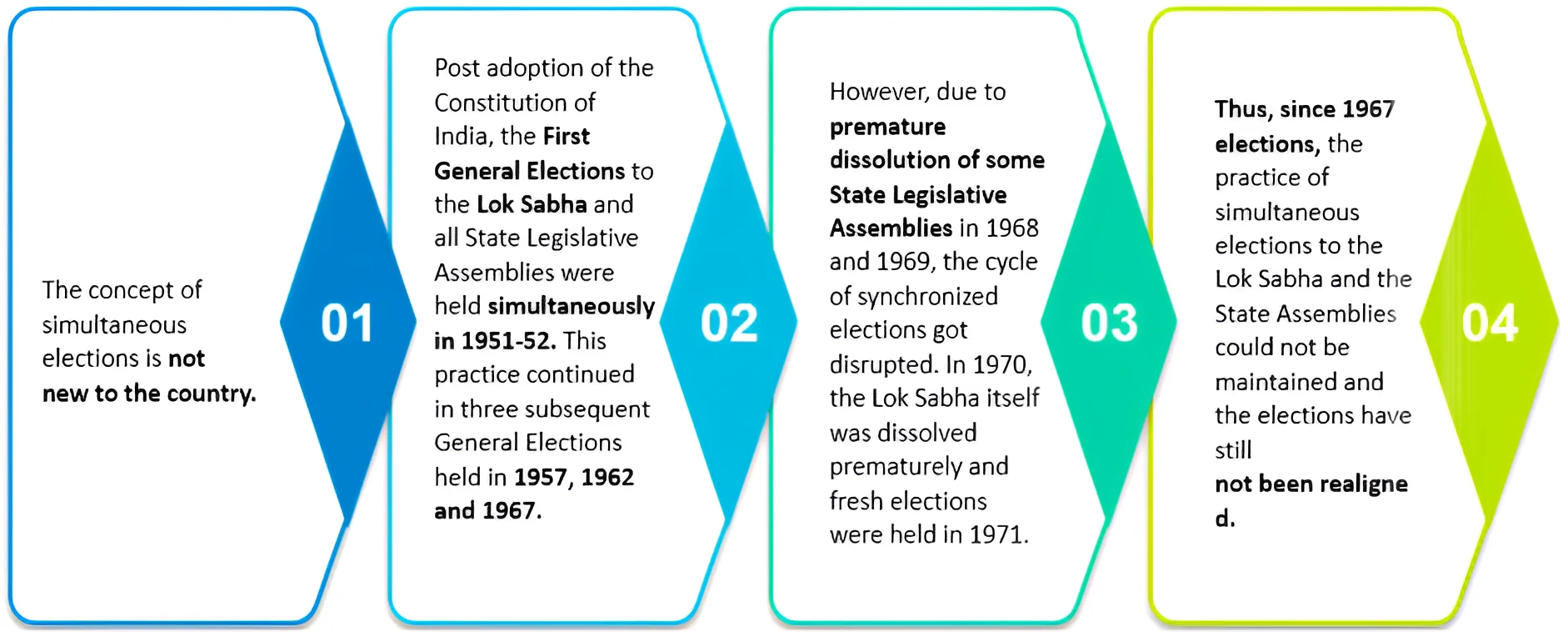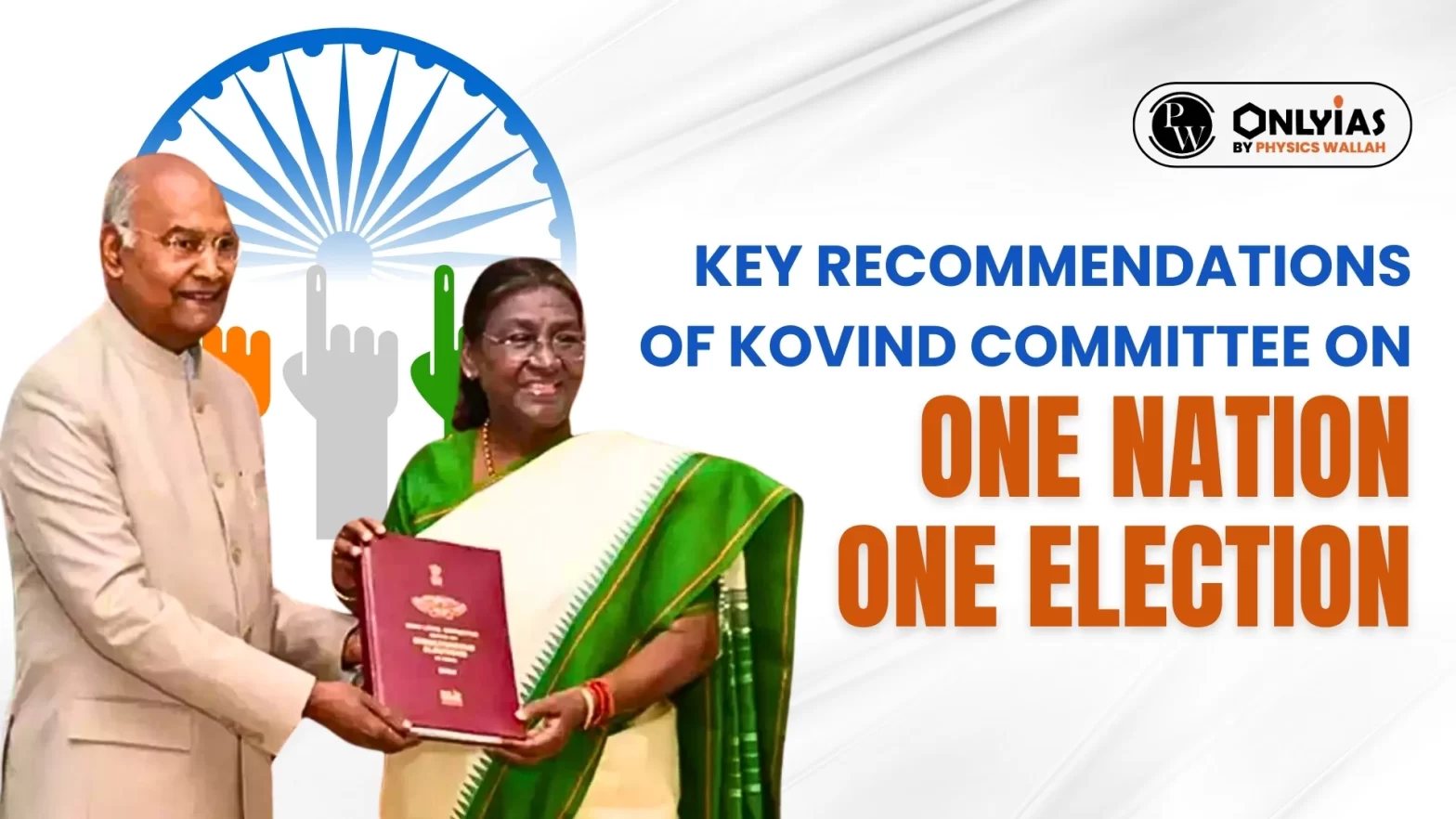Context
This Article is based on the news “What it will take to have simultaneous elections in India: Unpacking the Kovind committee report” which was published in the Indian Express. The High-level Committee (HLC) on One Nation One Election, chaired by former President Ram Nath Kovind, recently submitted its report to the President.
Kovind Committee Report On One Nation One Election: Key Highlights
-
Constitution of Kovind Panel:
- The High-level Committee (HLC), popularly known as the Kovind Panel, was constituted in September 2023 to study the possibility of simultaneous elections to all three levels of government.
-
Membership of the Panel:
- It included the following members:
- Home Minister Amit Shah
- Former Rajya Sabha Leader of Opposition Ghulam Nabi Azad
- Former Lok Sabha Secretary General Subhash C Kashyap
- Former chairman of the 15th Finance Commission N K Singh
- Senior Advocate Harish Salve
- Former Chief Vigilance Commissioner Sanjay Kothari
- Law Minister Arjun Ram Meghwal was a Special Invitee to the Committee.
-
High-level Committee (HLC) Recommendations:
- The HLC has unanimously endorsed the idea and recommended the way forward in the report.
Recommendations Kovind Committee Report On One Nation One Election

-
Amendments to the Constitution:
- Kovind committee report recommended amendments to:
- Article 83 deals with the duration of the Lok Sabha
- Article 172 deals with the duration of a state Assembly.
- No need for the state’s ratification.
-
Presidential Notification:
- This is likely to follow a Presidential notification.
- The notification will become null and void if the amendments fail to get parliamentary approval.
- If the amendments are adopted, simultaneous polls will become a reality, and the terms of most state governments will be truncated during the transition.
-
Two-Step Process:
- Elections for Lok Sabha and State Assemblies: In the first step, simultaneous elections will be held for Lok Sabha and State Assemblies.
- Elections to Local Bodies: In the second step, elections to municipalities and the panchayats will be synchronised with elections to Lok Sabha and state Assemblies.
- These elections must be held within 100 days of the elections to Lok Sabha and state Assemblies. This step will require ratification by at least one-half of the states.
-
Single Electoral Roll And Election ID:
- It proposed to amend the Constitution to facilitate the creation of a unified electoral roll and electoral photo identity cards for elections across all three tiers of government.
- Ratifying these amendments by at least half of the states would be necessary.
-
In Case of Hung House, Etc:
- In the case of a hung House or any such event, a fresh election to the House of the People will only be for the remainder of the term of the previous House.
- In the case of fresh elections to an Assembly, the new Assembly will continue only till the end of the term of the House of the People.
-
Meeting Logistics Requirements:
- The committee has recommended that to meet logistical requirements, the ECI will plan and estimate in advance, in consultation with the State Election Commissions.
- It should also take steps to deploy staffing, polling personnel, security forces, EVMs/VVPATs, etc.
What is Meant by One Nation One Election/Simultaneous Elections?
- Simultaneous elections, popularly referred to as “One Nation One Election”, means holding elections to Lok Sabha, all state Legislative Assemblies, and urban and rural local bodies (municipalities and panchayats) simultaneously.
- Currently, all these elections are held independently of one another, following timelines dictated by the terms of every individual elected body.

Background of One Nation One Election
- Conduct of Simultaneous Elections: In India, general elections for the House of the People and State Legislative Assemblies were held simultaneously in 1951-52, 1957, 1962, and 1967.
- Break in Simultaneous Polls Cycle:
- Due to successive central governments invoking constitutional provisions to dismiss state governments prematurely.
- With the frequent collapse of coalition governments at the state and central levels, the country began experiencing elections at different times throughout the year.
Benefits of One Nation One Election
-
Reduced Expenditure:
- Election expenses of political parties can be reduced if elections are held simultaneously. There would be no duplication of fundraising.
- This would save the public and business community from pressure for election donations multiple times.
- It will bring considerable savings to political parties and candidates in their election campaigns.
- It is estimated that the cost of holding general elections to the Lok Sabha is around ₹4,000 crore for the Central government. Each State assembly election would also cost a considerable amount of money according to the size of the State.
Committees and Reports:
- Election Commission: The idea of simultaneous elections was first formally proposed by the ECI in its 1983 report.
- The commission suggested that conducting simultaneous polls could reduce elections’ frequency and associated costs.
- Law Commission: It also examined the issue and submitted several reports suggesting measures to synchronise the terms of the state legislatures with those of the Lok Sabha.
- Niti Aayog: In 2017, the Niti Aayog released a paper titled ‘Election Time Table’, discussing the feasibility of simultaneous elections. It suggested a practical roadmap for implementing the concept.
|
-
Mitigate the Issue of Model Code of Conduct:
- It can mitigate the issue of the Model Code of Conduct, which sometimes hinders the government from announcing projects or policy plans. By and large, no decisions are taken during elections due to the code of conduct. Therefore, key policy decisions get delayed at the Centre, the states, and local bodies.
-
Improved Governance:
- Simultaneous elections will allow elected governments and ruling parties to concentrate on governance rather than diverting their attention towards frequent election preparations in various regions.
- Parties in government and the Opposition at both the Centre and states could concentrate on policy matters until the next general elections. Technical work presented by the panel shows that outcomes in the context of growth, inflation, investment, and public expenditure tend to be better after periods of synchronised elections.
-
Smooth Delivery of Public Services:
- Deputing government employees frequently on election duty can hinder public services, resulting in challenges to the smooth functioning of government operations and delivery of services to the public.
- Even when no fresh policy decision is necessary, implementation of ongoing projects gets derailed during election periods as the political executive as well as government officials would be engaged with election duties, neglecting routine administration.
-
Reducing Burden of Personnel Deployment:
- A large number of police personnel and para-military forces are engaged to ensure that elections are conducted peacefully.
- This involves massive redeployment and huge costs. It also diverts key law enforcement personnel from their critical functions. Such deployment can be curtailed with simultaneous elections.
-
Uniform Electoral Rolls:
- The same electoral rolls can be used for all the elections. This will save tremendous time and money spent on updating electoral rolls.
- It will also make it easier for the citizens as they would not have to worry about their names missing from the electoral rolls once they are enlisted.
-
Curbing Black Money:
- Frequent elections have been associated with the possibility of black money being turned into white money, leading to the emergence of a parallel economy. Holding one-time elections could help reduce such a possibility.
-
Fostering Unity:
- Simultaneous polls promote a national perspective over regional ones, which is important for cultivating unity within the country.
Challenges Associated With One Nation One Election/ Simultaneous Elections
- Conducting Mid-Term Elections: It is a challenge to devise a mechanism to hold simultaneous elections because fresh elections may be needed for the House of the People or Assemblies before the completion of their terms for various reasons.
- Alteration of Basic Structure: Implementing simultaneous polls would require amendments in at least five articles of the Constitution to the Constitution (83, 85, 172, 174 and 356).
- Legal challenges:
- Simultaneous elections may also require amendments to anti-defection laws to prevent legislators from switching parties in line with the election cycle, which could potentially weaken the spirit of the concept.
- EVM Expenses: Doubling expenses on electronic voting machines (EVMs) could offset the potential savings from simultaneous polls.
- Model Code of Conduct (MCC): It is argued that it only prevents ruling parties from using government machinery for electoral gains rather than paralysing policy-making as overstated by some opponents.
- Challenges of Federalism: India has a federal structure with the division of powers between the central and state governments. Simultaneous elections are an attack on the autonomy and independence of state governments.
- State governments in India have a large degree of autonomy and can oppose any move that violates their powers and attacks the autonomy of the states.
- Moreover, the local elections follow a decentralised system of governance in which local bodies enjoy significant autonomy.
- The simultaneous elections may affect their independent functioning, which is constitutionally protected.
- This can weaken this federal structure and increase the conflict of interest between the Centre and states.
- Financial and Administrative Challenges: Its implementation will require the allocation of massive financial and administrative resources.
- Logistic Challenges: Logistical challenges could arise in organising simultaneous elections once every five years, especially with the deployment of security forces in large numbers for free and fair conduct.
- Change in Voting Behaviour: Every voter has different considerations and voting preferences at national, state and regional levels.
Global Perspective:
- South Africa: Elections are held for the National Assembly, Provincial Legislature and Municipal Councils in a five-year cycle.
- The electoral system for National and Provincial Assemblies is based on “party-list proportional representation”, which means that parties are represented in the proportion of electoral support to them.
- Sweden: Elections to Sweden’s County Councils and Municipal Councils occur simultaneously with the general elections.
- Whereas, the elections of the Municipal Assemblies occur generally on the second Sunday of September after every five years.
|
-
- Simultaneous polls run the risk of national issues overshadowing local concerns in simultaneous elections. This will have the potential impacts on voter decision-making.
- Fading of Local Issues: Mixing of national and regional issues will lead to fading of local issues, distorting priorities and giving an unfair advantage to national parties over regional ones.
- Feasibility: Concerns arise over the feasibility of conducting elections across all state governments if a coalition central government collapses.
- Consensus Among Political Parties: Achieving political consensus on holding simultaneous polls among different political parties, especially regional parties, is a legal and political challenge.
- International Examples Not Suitable for India: Comparing international examples (Sweden, Belgium, South Africa) to India may not be suitable due to the vast differences in population and area.
Way Forward
- Political parties under RTI: In order to ensure better transparency, accountability and democracy within political parties, bringing them under the framework of the Right to Information Act is recommended.
- Free and Fair Elections: Strengthening the role of ECI as a regulator and enhancing its monitoring capabilities to oversee poll expenditure at all levels would contribute to conducting free and fair elections.
- Electronic Voter ID cards: The use of IT-enabled tools like electronic voter ID cards can help eliminate bogus electors from electoral rolls, improving the accuracy and integrity of the voter registration process.
- State Funding of Elections: Exploring the idea of state funding for elections is proposed as a measure to reduce the influence of money power in politics and promote a level playing field for candidates.
- Broad Consensus: The government will have to obtain consensus of all political parties as well as all state governments.
Conclusion
It is important that the recommendations are taken forward only with a wider political consensus. This is crucial because most national parties are not in favour of the idea. Holding simultaneous elections is not an end worth achieving if it undermines democratic values.
Also Read: Supreme Court Verdict On Chandigarh Mayor Elections
| Prelims PYQ (2020):
Consider the following statements:
1. According to the Constitution of India a person who is eligible to vote can be made a minister in a State for six months even if he/she is not a member of the Legislature of that State
2. According to the Representation of People Act, 1951, a person convicted of a criminal offence and sentenced to imprisonment for five years is permanently disqualified from contesting an election even after his release from prison Which of the statements given above is are correct?
(a) 1 only
(b) 2 only
(c) Both 1 and 2
(d) Neither 1 nor 2
Ans: (d) |
![]() 15 Mar 2024
15 Mar 2024



